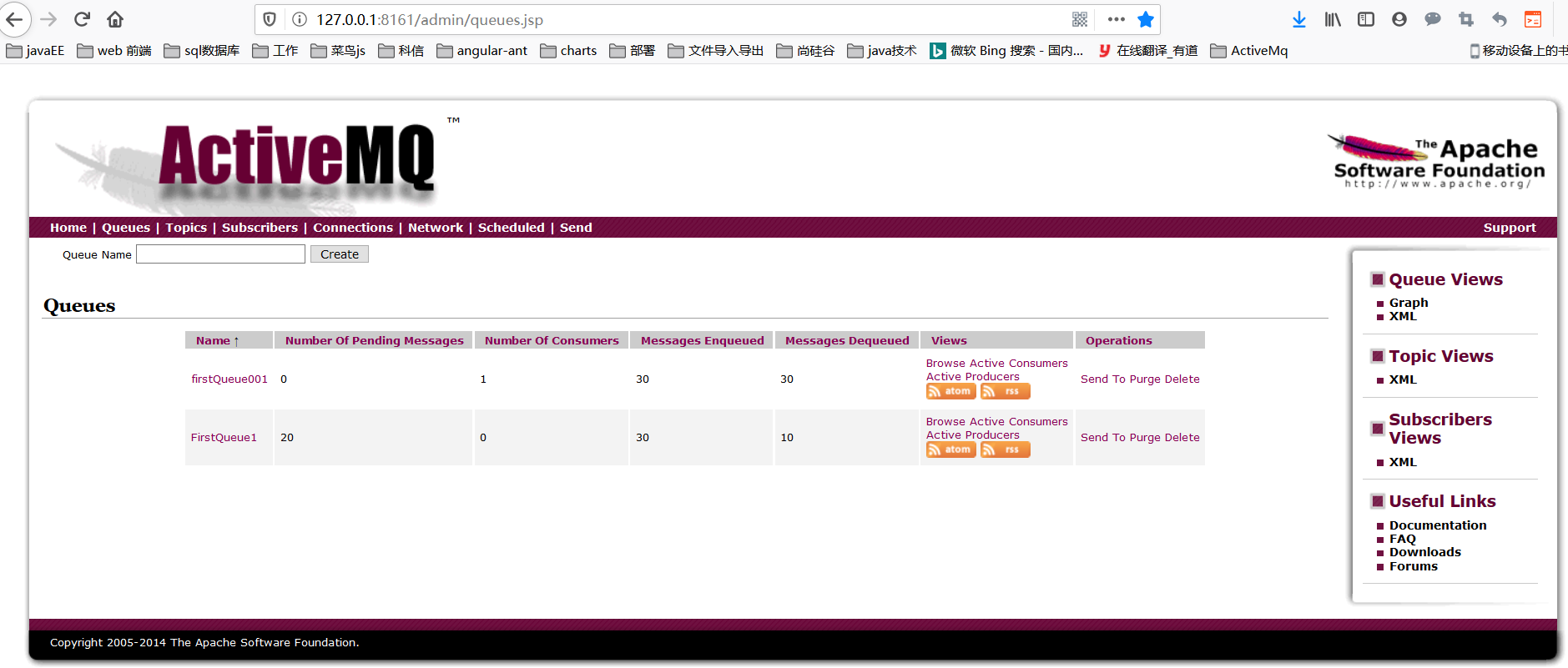点对点(Point-to-Point)。在点对点的消息系统中,消息分发给一个单独的使用者。点对点消息往往与队列(javax.jms.Queue)相关联。
有两种消费形式,我们此次只介绍listener模式(代码冗长,后期的util需自己封装)
- 实时监听,消费者监听生产者的生产状态
- 定时刷新 recive模式(不实用,不推荐
版本:apache-activemq-5.11.1 官网下载
主页:http://activemq.apache.org/
目前最新版本:5.11.1
开发包及源码下载地址:http://activemq.apache.org/activemq-5111-release.html
ActiveMQ 服务启动地址:http://127.0.0.1:8161/admin/ 用户名/密码admin/admin
1.生产者JMSProducer
/** * 消息生产者 * @author Administrator * */ public class JMSProducer { private static final String USERNAME=ActiveMQConnection.DEFAULT_USER; // 默认的连接用户名 private static final String PASSWORD=ActiveMQConnection.DEFAULT_PASSWORD; // 默认的连接密码 private static final String BROKEURL=ActiveMQConnection.DEFAULT_BROKER_URL; // 默认的连接地址 private static final int SENDNUM=10; // 发送的消息数量 public static void main(String[] args) { ConnectionFactory connectionFactory; // 连接工厂 Connection connection = null; // 连接 Session session; // 会话 接受或者发送消息的线程 Destination destination; // 消息的目的地 MessageProducer messageProducer; // 消息生产者 // 实例化连接工厂 connectionFactory=new ActiveMQConnectionFactory(JMSProducer.USERNAME, JMSProducer.PASSWORD, JMSProducer.BROKEURL); try { connection=connectionFactory.createConnection(); // 通过连接工厂获取连接 connection.start(); // 启动连接 session=connection.createSession(Boolean.TRUE, Session.AUTO_ACKNOWLEDGE); // 创建Session destination=session.createQueue("FirstQueue1"); // 创建消息队列 messageProducer=session.createProducer(destination); // 创建消息生产者 sendMessage(session, messageProducer); // 发送消息 session.commit(); } catch (Exception e) { // TODO Auto-generated catch block e.printStackTrace(); } finally{ if(connection!=null){ try { connection.close(); } catch (JMSException e) { // TODO Auto-generated catch block e.printStackTrace(); } } } } /** * 发送消息 * @param session * @param messageProducer * @throws Exception */ public static void sendMessage(Session session,MessageProducer messageProducer)throws Exception{ for(int i=0;i<JMSProducer.SENDNUM;i++){ TextMessage message=session.createTextMessage("ActiveMQ 发送的消息"+i); System.out.println("发送消息:"+"ActiveMQ 发送的消息"+i); messageProducer.send(message); } } }
2.listener编写
/** * 消息监听 * @author Administrator * */ public class Listener implements MessageListener{ @Override public void onMessage(Message message) { // TODO Auto-generated method stub try { System.out.println("收到的消息:"+((TextMessage)message).getText()); } catch (JMSException e) { // TODO Auto-generated catch block e.printStackTrace(); } } }
3.消费者
/** * 消息消费者 * @author Administrator * */ public class JMSConsumer2 { private static final String USERNAME=ActiveMQConnection.DEFAULT_USER; // 默认的连接用户名 private static final String PASSWORD=ActiveMQConnection.DEFAULT_PASSWORD; // 默认的连接密码 private static final String BROKEURL=ActiveMQConnection.DEFAULT_BROKER_URL; // 默认的连接地址 public static void main(String[] args) { ConnectionFactory connectionFactory; // 连接工厂 Connection connection = null; // 连接 Session session; // 会话 接受或者发送消息的线程 Destination destination; // 消息的目的地 MessageConsumer messageConsumer; // 消息的消费者 // 实例化连接工厂 connectionFactory=new ActiveMQConnectionFactory(JMSConsumer2.USERNAME, JMSConsumer2.PASSWORD, JMSConsumer2.BROKEURL); try { connection=connectionFactory.createConnection(); // 通过连接工厂获取连接 connection.start(); // 启动连接
//消费者不需要开启事务 参数一:是否开启事务 参数二:消费类型 session=connection.createSession(Boolean.FALSE, Session.AUTO_ACKNOWLEDGE); // 创建Session destination=session.createQueue("FirstQueue1"); // 创建连接的消息队列 messageConsumer=session.createConsumer(destination); // 创建消息消费者 messageConsumer.setMessageListener(new Listener()); // 注册消息监听 } catch (JMSException e) { // TODO Auto-generated catch block e.printStackTrace(); } } }
4.session方式说明
Session.AUTO_ACKNOWLEDGE。当客户成功的从receive 方法返回的时候,或者从MessageListener.onMessage
方法成功返回的时候,会话自动确认客户收到的消息。
Session.CLIENT_ACKNOWLEDGE。客户通过消息的acknowledge 方法确认消息。需要注意的是,在这种模
式中,确认是在会话层上进行:确认一个被消费的消息将自动确认所有已被会话消费的消息。例如,如果一
个消息消费者消费了10 个消息,然后确认第5 个消息,那么所有10 个消息都被确认。
Session.DUPS_ACKNOWLEDGE。该选择只是会话迟钝第确认消息的提交。如果JMS provider 失败,那么可
能会导致一些重复的消息。如果是重复的消息,那么JMS provider 必须把消息头的JMSRedelivered 字段设置
为true。
5.测试主页面